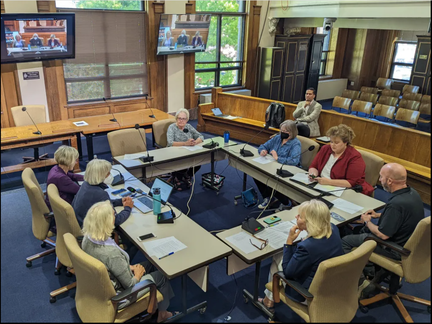|
NOTE: This article that highlights President & CEO, Eric Spoonmore's, involvement was published in the August 31, 2022 B Square Bulletin by Dave Askins. Photos are gathered from the article as well.  Convention center work session at county courthouse. (Photo by: B Square Bulletin) Convention center work session at county courthouse. (Photo by: B Square Bulletin) On Wednesday at noon, the possible expansion of the county convention center was the topic of a meeting of Monroe County and Bloomington officials. The gathering at the county courthouse included county commissioners, some county councilors, city councilmembers and the mayor’s office. It was the first time that representatives from all four groups had sat at the same table on that topic since early March of 2020, just before the COVID-19 pandemic hit. After about 45 minutes of conversation, the group had not made much progress, but agreed it was worth another meeting. The city wants to get a deal done by the end of September. So “sooner rather than later” was the city’s wish for a next scheduled meeting. One twist that emerged on Wednesday was the possibility that a convention center deal between the city and the county could hinge on Bloomington’s approval of a rezone for land that the county wants to use for construction of a new jail. At the table were: Mary Catherine Carmichael (Bloomington’s director of public engagement); Susan Sandberg and Sue Sgambelluri (president and vice president of the Bloomington city council); Lee Jones, Julie Thomas, and Penny Githens (Monroe County commissioners); and Cheryl Munson Geoff McKim (Monroe County councilors).
Wednesday’s meeting came after a recent pitch from the city to restart the effort to expand the convention center, which had long been in the works, but had stalled in early March of 2020. The city of Bloomington’s pitch to the county to restart the expansion effort is essentially to scrap the collaboration. Instead, Bloomington wants the county government to transfer convention center real estate to Bloomington with some compensation to be negotiated. On Bloomington’s proposal, the city would handle the convention center expansion on its own. Two and a half years ago, the main obstacle, for what was supposed to be a joint city-county collaboration, appeared to be the governance structure for the convention center expansion. The two sides were trying to sort out some kind of arrangement for sharing the appointments to a capital improvement board (CIB). Under state statute, it’s the county commmissioners who decide which government entities make appointments to a CIB. On Wednesday, Bloomington’s director of public engagement, Mary Catherine Carmichael, told the group: “Mayor Hamilton has made it clear to me that he’s not interested in pursuing a CIB model.” When county commissioner Julie Thomas asked Carmichael why the CIB model was off the table, Carmichael alluded to some reasons she’d mentioned earlier. Those reasons included the city’s preferred alternative to a CIB, which is a 501(c)(3) nonprofit. Carmichael contended that forming a 501(c)(3) would be a more “nimble” approach. Some nimbleness could be required, because of what Carmichael described as a law now being drafted by state legislators for their 2023 session, to sunset food and beverage taxes (FBTs). Earlier this year, state lawmakers mulled the idea of sunsetting (FBTs) across Indiana. That legislation passed the senate but the house allowed it to die in committee. The funding for the convention center expansion would come from Monroe County’s FBT. One way to keep Monroe County’s FBT alive would be to have bonds already issued for the convention center expansion. That would insulate Monroe County’s FBT from legislative action. On Wednesday, there was some question in the group about whether forming a CIB would be any less nimble an approach than forming a 501(c)(3). For county councilor Geoff McKim, the mechanism for governance is not as important as getting the bonds issued. He said, “I am neutral on the means of governance going forward. I would just very strongly echo…other colleagues on the county council, that we would like to see the convention center expansion move forward, and move forward expeditiously.” For McKim, it’s not just about getting bonds issued before possible action by the state legislature. It’s about fulfilling the promise made to the public, when the county council enacted the tax in 2017. One of the items on the proposed term sheet calls for the city to transfer to the county health department the city’s share of the statewide opioid settlement, which amounts to a total of about $1.9 million. The roughly $1.9 million that Bloomington anticipates receiving from the opioid settlements are supposed to be paid out by drug companies over a period of 18 years. In addition, 70 percent of the local government settlement share has to be used for treatment, prevention, and care. On Wednesday, Thomas indicated that she thought the idea of the county’s health department handling the city’s share of the settlement money makes sense—but not as a part of a deal on the convention center. About the transfer of opioid settlement money, Thomas said, “I don’t really see that as a part of a sale of property or transfer of property.” Thomas added, “I think this is its own thing, and it should be brought to the health board—they may very well be willing to do it.” The real estate that is to be transferred to the city includes the convention center itself, at College Avenue and 3rd Street. It also includes other parcels between Walnut Street and College Avenue that the county has acquired with revenue from the county innkeeper’s tax. The city wants to analyze the situation as one where the public has already paid for the real estate. So from the city’s point of view, for the city to pay the county for the real estate would amount to the public paying twice for it. Carmichael put it like this: “We don’t look at this as a traditional sale, but more of a transfer, because you wouldn’t want to ask the public to pay for something twice.” Regardless of what agreement the city and county might reach, on the transfer or sale of the downtown real estate, Thomas said she would not sign off on a convention center deal until the county had nailed down a location for its planned new jail. What Thomas implied on Wednesday was that the county’s downtown property envisioned for the convention center might have to be used for a different purpose—to build a new jail. McKim’s counter to that was to say he would not vote (as a member of the county council) to appropriate even one dollar to support construction of a jail on the downtown parcels that to which Thomas was alluding. The future jail location preferred by the county is an 87-acre parcel in the southwest corner of Bloomington, which would need to be rezoned in order to be used as a jail facility. The rezone is supposed to appear on the September 12 plan commission agenda. At the plan commission’s Aug. 16 work session, it was not clear if that requested rezone, so that a jail can be built on the parcel, will have the Hamilton administration’s support. At that work session, development services manager Jackie Scanlan responded to a plan commissioner question by saying that the administration does not yet have a position on the rezone. Whatever the plan commission recommends, it’s the city council that will have the final decision on any rezone of the 87 acres. If the plan commission were to recommend approval of the rezone on Sept. 12, then based purely on the meeting calendar it could appear on the city council’s agenda as early as its regular meeting set for Sept. 21. But that probably would not meet the 10-day published notice requirement. In any event, Thomas’s remarks can be analyzed as a kind of offer: Once the 87 acres gets approval for a rezone to build the jail, she could be willing to negotiate a real estate deal on the convention center expansion.
0 Comments
Leave a Reply. |
Chamber NewsThis blog contains press releases, other news updates from the Chamber, news articles and radio interviews featuring interviews with the Chamber and team members, and much more! Categories
Categories
All
Archives
Archives
July 2024
|
|
Copyright The Greater Bloomington Chamber of Commerce. All Rights Reserved.


 RSS Feed
RSS Feed
